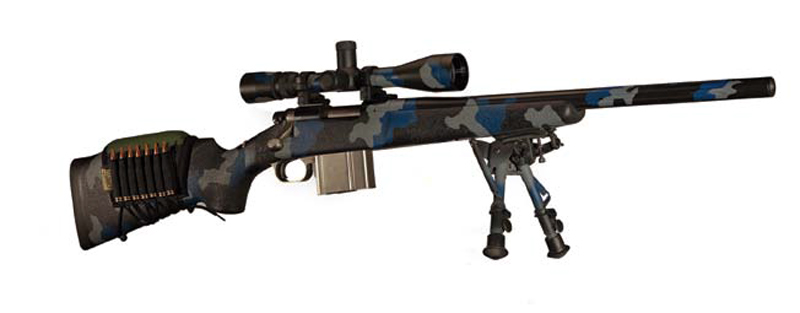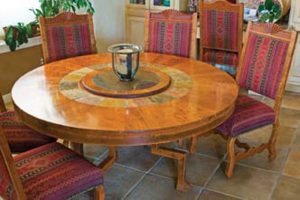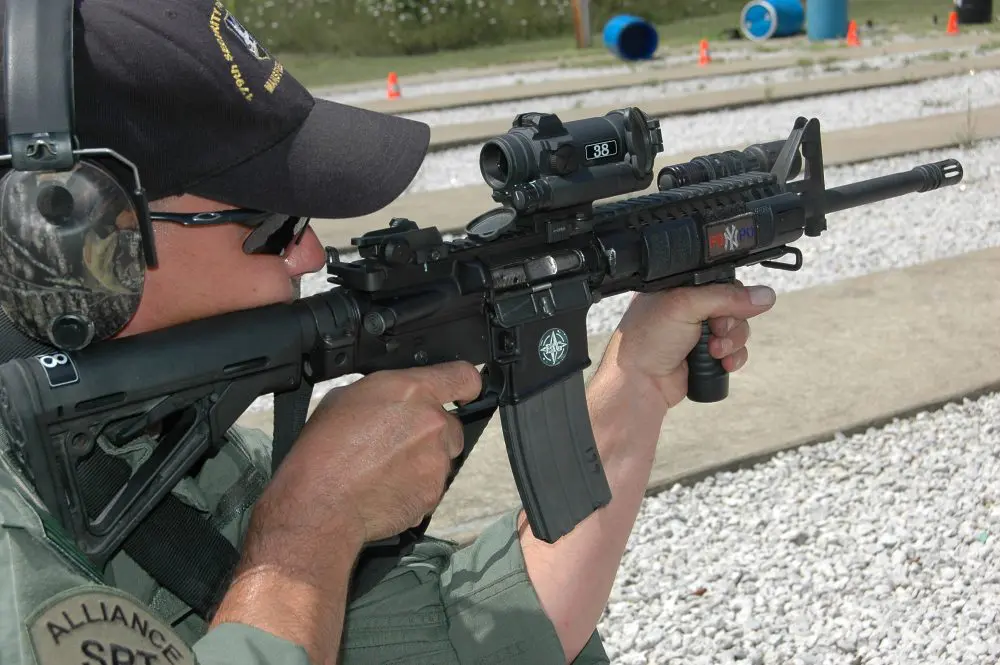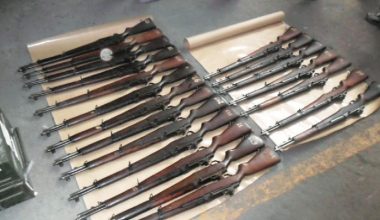


Almost a century later, this same motto could apply to Robbie Barrkman, head honcho of The Robar Companies, Inc. and Coating Technologies, Inc. And like Rolls-Royce, Barrkman provides various products and services without sacrificing quality or after-sales service.
Is this author personally biased in favor of Robar’s service? Yes. Is Mister Barrkman one of very few people to whom I attach the word “friend”? Yes. But that doesn’t mean I would presume to insult S.W.A.T. readers’ intelligence with my personal biases. My (and thousands of clients’) opinions are based on nearly 30 years of customer satisfaction.
Table of Contents
PERSONAL HISTORY
A short history: I first encountered Robbie three decades ago at Jeff Cooper’s original American Pistol Institute (later known as Gunsite Training Center). I had recently immigrated to the United States to work for the Colonel, and Barrkman was already established as Senior Rangemaster and Gunsmith. At the top of my priority list was replacing personal firearms given away and/or sold on my exodus from my native South Africa.
Robbie was tasked with custom building a Remington shotgun and Colt .45 auto pistol, with the caveat that if they weren’t exactly to my requirements, he could forthwith consider his birth certificate cancelled. The 870 is still in use, and the pistol was retired twenty years later, without—except for operator error—a single malfunction from either weapon.
Score One for Robar: quality, longlasting products. This was long after he had built up a large dental laboratory in South Africa.
Score Two for Robar: mechanical competence and business acumen. (He then built up another laboratory in the United States.) And he had previous frontline battle experience as the youngest Sergeant Major in the South African Defence Force.
Score Three for Robar: invaluable first-hand experience when providing firearms equipment for gunfighters, soldiers, police officers and participants in self-defense training. Years earlier, he had also been selected as a member of the national Springbok IPSC team at the World Shoot in Salzburg, Austria. (His late mother was also a Springbok pistol shootist, receiving her “colors” for target shooting.)
Score Four for Robar: marksmanship ability and genetics. Barrkman was also responsible for special projects like the custom-built spare cartridge release system on Colonel Cooper’s prototype Scout Rifles.
Score Five for Robar: ingenuity.
Need I go on with the historical revue, or does the reader get the point that Robbie Barrkman is as close as you can get to being the ideal combination of experience and physical and mental capability to run a company like Robar?
The question is, does the company fulfill its promise of potential?
And the answer is—at least in this author’s opinion—a definitive “yes.”
Robar’s gunsmithing services started like so many other “necessity is the mother of invention” success stories. Forty years ago, Barrkman started working on his own weapons after becoming disillusioned with local gunsmiths. One shooter saw his work and asked him to replicate it on his pistol. Soon one became two, two became three … and 40 years later, thousands of customers have utilized the services of Robar and its sister company, Coating Technologies Inc (CTI).


SYMBIOSIS
How does this combination of personal ability and business acumen culminate in quality products and service for the customer? First and foremost, the symbiotic marriage between The Robar Companies and CTI provides a one-stop shopping complex housed in one giant building complex. This negates the obvious customer downside of having firearms construction and/or service performed by one contractor, then having a second unrelated party completing another facet of the service.
For example, if you wish to have a weapon built, it will be built by Robar to your specifications and then internally and externally coated and/or plated for mechanical function, external durability and cosmetics by CTI—all in one location.
Has Barrkman encountered the rare dissatisfied customer? Yes. But so have Ford, GMC, Toyota, doctors, and manufacturers of microwave ovens and child cribs. Let’s face it, the only companies that never hear from a dissatisfied client are funeral homes and manufacturers of faulty parachutes. You can’t make everybody happy. What you can do, however, is provide aftermarket service to amend the situation and utilize a system that will nullify in advance the human error factor as best you can.
And Robar has done this in two distinct ways.
Firstly, any order—especially custom orders—is processed with written instructions and a job card.
Secondly, prior to being sent to the customer, every product is inspected for quality control by two fellow machinists who did not actually perform the work. A company can do no more than this. Robbie takes pride in both his personal reputation and customer satisfaction.
EXPERT ADVICE
Custom one-off firearms orders will be executed only if the customer’s request remains within the bounds of mechanical safety. If, for example, you want a two-pound trigger on your Glockencolt, you won’t be getting it done by The Robar Companies. Any other “reasonable” customization will be performed, even if it’s something like having an SR90 sniper rifle emblazoned in pink and purple with your mistress’ initials, but will be preceded by a conversation involving a staff member’s professional input, advice and suggestions.
The problem with firearms owners is that, like car enthusiasts, they often place cosmetics before function. That’s why you see somebody driving a Mini Cooper with 20-inch wheels, or a pickup truck with the suspension lowered to allow only a hair’sbreadth of ground clearance. To each his own, and as long as it doesn’t set up a potential safety problem, Robar will do it if the customer really wants it, but with the ultimate bottom line being that function is the absolute primary, and the “look cool” effect is secondary.
It used to be called “built for go, and not for show.” Now, thanks to the Robar/ CTI symbiosis, you can have both, but the “go” absolutely comes first. They build working firearms, not gun-safe queens.
SERVICES
In a nutshell, The Robar Companies builds and modifies firearms, while CTI does the plating and cosmetics. CTI is, however, Aerospace certified, and its output also includes non-firearms related services such as plating of internal mechanical parts on various military aircraft.
While Robar provides “generic” services like trigger jobs, sight installations and accuracy and reliability packages on pistols, they are known for several distinct services. And while the word “innovator” is overused today, Barrkman is a true innovator. For example, his company is renowned for the grip reduction and texturing process on Glock pistols. It all started with a law enforcement rangemaster whose department was issued a specific model Glock as a service pistol. Encountering a small-handed female officer who couldn’t wrap her sweaty little paws around the weapon, he asked Robbie if he could do “something” to the pistol to facilitate the officer’s firing grip. And the grip reduction was born.
Big deal, you say. Today I can buy a Generation 4 Glock, Ruger, Smith & Wesson M&P, or Springfield XDM with interchangeable backstraps. Agreed, but in this author’s humble opinion, these factories were virtually forced to do this or they would have lost sales to their competition. And even though the interchangeable backstrap does help, (a) it’s not a new idea (witness Colt’s flat and arched mainspring housings from a hundred years ago), and (b) it still doesn’t really reduce the overall grip size. It only reduces the distance from backstrap to trigger, which isn’t the same thing.
And if you think The Robar Companies wasn’t the originator of the entire evolution, you probably spend hours on your computer wondering why you can’t find waterproof swim trunks for sale for your pet frog.
Yes, he’s an innovator.
He has also, over the last couple of years, extended this process to weapons like the HS2000—known in the United States as the Springfield XD—and I have even seen it executed on a customized Ruger LCP. Barrkman’s company also offers a beavertail modification for Glocks for shooters with large hands who get their hands sliced from slide bite.
Other pistol modifications include outof- the-ordinary services like an excellent treatment of the Sig double-action trigger, and many and varied finishes, both internal and external.
SHOTGUN MODIFICATIONS
The company line of shotgun modifications is legendary—and has been for over 25 years—following a Special Weapons class conducted by John Satterwhite at Jeff Cooper’s original American Pistol Institute. Under Jeff’s guidance and directive, Robbie constructed modifications to the already idiot-proof base Remington 870. Between the Colonel’s foresight and resultant regeneration of the shotgun as a viable defensive weapon and Barrkman’s mechanical aptitude was spawned the now much-copied trademark-shaped front sight, customized one-piece magazine extension, modified shortened stock, and ghost-ring rear sights.
Over 25 years later, you see virtually the same weapon being offered by most producers of “tactical” firearms. As Brett Favre said, “It’s hard to reminisce when you’re the only one who was there.”
In addition, unusual requests, such as a custom SideSaddle ammo-carrier mount for an A5 Browning customer, have been superbly crafted like they were run-ofthe- mill shotgun modifications. Once accepted, virtually no challenge has been too big or too small for this company’s ingenuity.
Another brainchild conceived between Colonel Cooper’s vision and Robbie’s mechanical execution was the aforementioned ingenious spare cartridge retention system housed in a sliding receptacle in the stock of one of Jeff’s early Scout Rifle prototypes in the early 1980s.
ROBAR RIFLES
Since then, Robar has gone on to produce their outstanding line of rifles, like the SR60, SR90, and Quick Reaction QR2 rifles. They are all guaranteed to shoot into one-half minute-of-angle (based on the caveats that you follow the manufacturer’s cleaning instructions, use appropriate ammunition, and shoot better with your trigger finger than you do with your lips). And appropriate ammunition means that you inform Robar what bullet you are using and they will use a barrel with a symbiotic rate of twist.
The SR60 and SR90 are sniper rifles, with the latter having a stock with multiposition adjustment capability. Using a Surgeon action, Lilja or Schneider barrels, McMillan stocks, and Accuracy International magazines, they are not “partsassembled” kits. They are one-off custombuilt rifles. Figure it out—nobody but an idiot would guarantee one-half MOA accuracy, no matter how good the quality of the individual component parts.
The QR2 is a multi-purpose rifle. It is compact for quick, ugly work, but has extreme accuracy capability at distance, determined primarily by the choice of optical equipment. Based on the Remington 700 action, coupled to a Lilja 20-inch barrel and mated to a Sako Varminterstyle McMillan stock, the Quick Reaction Rifle is also available with a folding stock and Badger Ordnance box magazine-fed capability. It is one of The Robar Companies’ top sellers.
The SR60 and SR90 have been used for over two decades by law enforcement and military Special Operations units both in the United States and overseas. Again, the proof is in the pudding. There’s no substitute for experience.

CTI PROCESSES
Coating Technologies Inc. offers seven coating and/or plating processes, all of which have different properties.
There is “generic” bluing and Parkerizing, which is also offered by virtually every gunsmith on the planet. While CTI’s bluing—and that of many other companies—initially coats and protects metal surfaces and looks attractive, they will not stand up to hard use (such as in a Kydex holster) before showing signs of wear and exposing the base metal to the elements.
There is electroless nickel, which provides much more corrosion resistance but requires lubrication on reciprocating surfaces.
Chrome sulfide is offered and utilized primarily to blacken stainless steel. It’s not as hard-wearing as some of CTI’s other finishes but is ideal for some situations. (I have had all my personal XD magazines plated with chrome sulfide, since I don’t like using my magazines as signaling mirrors for people who are shooting at or scouting me.)
Roguard is a molybdenum disulfidebased polymer. In essence, it’s a professionally applied paint-and-bake process. A lot harder-wearing than traditional bluing or Parkering, it too will eventually mar with hard use and abuse.
Moving up the scale and leading to The Big Two—in this author’s opinion— is PolyMax. The forebear of PolyT2, PolyMax is not as wear-resistant as its offspring, but is available in whatever color you desire.
Then there are the Big Two: PolyT2 and NP3®.
PolyT2 is a teflon-based finish, available in Black, OD Green, Tan, and Gunmetal Gray. It is the latest generation of Coating Technologies’ offerings and is my choice for any parts I haven’t had plated with NP3. This opinion is based on a five-month torture test on a range pistol.
The slide was plated and used in training classes in a Kydex holster and to date, in addition to thousands of manipulation processes, has endured a conservatively estimated 13,000 to 15,000 drawstrokes and reholstering procedures. This numerical figure probably exceeds that of any pistol-toter save for the most devout of competition-shooting, drawstrokepractice devotees. The lack of visual wear is nothing short of astounding, and is a far cry from its PolyMax forebear—and more expensive. There is, however, an axiom that comes to mind: “You get what you pay for.”
As an aside, while CTI claims that PolyT2 is self-lubing (and it did appear to be so during an extended range session on a subsequently plated carry pistol), I remember my dear departed Mother manually cleaning a self-cleaning oven. So either out of deference to my Mother or out of habit, I still clean and lubricate my weapons after use, as circumstances allow. But it’s nice to know that I have a back-up insurance policy.
And last but decidedly not least is NP3. It is a proprietary process that nobody but Coating Technologies Inc. can provide, and has extreme lubricity, anti-corrosion and adhesion properties. This process has been refined and improved over the years by CTI down to a fine art, with a huge advantage over any other plating or coating process: its thickness can be controlled on application. This explains why, apart from its outstanding properties, its customers range from nitwits like I to builders of fighter aircraft.
THE MAN
From his hobby of woodworking, which has turned out exquisite home furniture that would sell at double the price of factory products if he so chose, to his professional-grade photography, Robbie Barrkman is a true Renaissance Man. And he has the most valuable of assets—a long-serving, dedicated staff.
Yes, I’m biased when it comes to Robar and CTI products and service. But when Robbie drops his public veiled façade, and you see the inner man, who approaches everything he does full-bore—and excels at most—it shouldn’t be surprising that his companies are so successful.
“Take the best and make it better. If it doesn’t exist, create it. Accept nothing nearly right or good enough.”
It’s nice to see that, a century later, some companies still live by Henry Royce’s credo.





